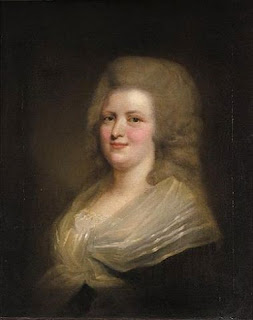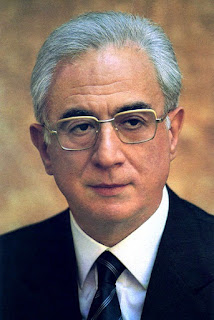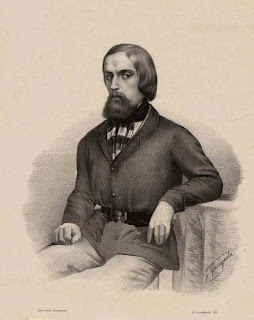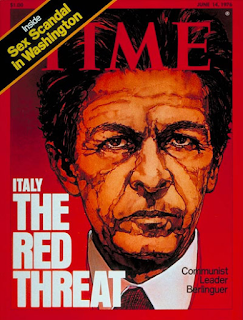Monarch who was descended from Charles I of England
 |
| Court painter Domenico Duprà's portrait of Charles Emmanuel IV |
Charles Emmanuel IV, who was King of Sardinia from 1796
until he abdicated in 1802 and might once have had a claim to the throne of
England, was born on this day in 1751 in Turin.
Born Carlo Emanuele Ferdinando Maria di Savoia, he was the
eldest son of Victor Amadeus III, King of Sardinia, and of his wife Infanta
Maria Antonia Ferdinanda of Spain. From his birth he was known as the Prince of
Piedmont.
In 1775, he married Marie Clotilde of France, the daughter
of Louis, Dauphin of France, and Princess Marie-Josèphe of Saxony, and sister
of King Louis XVI of France.
Although it was essentially a political marriage over which
they had little choice, the couple became devoted to one another.
With the death of his father in October 1796, Charles
Emmanuel inherited the throne of Sardinia, a kingdom that included not only the
island of Sardinia, but also the whole of Piedmont and other parts of north-west
Italy.
He took on a difficult political situation along with the throne,
only months after his father had signed the disadvantageous Treaty of
Paris with the French Republic following the four-year War of the First
Coalition, in which Napoleon’s army prevailed. The treaty ceded the Duchy of
Savoy and the County of Nice and gave the French army free passage through
Piedmont to attack other parts of Italy.
 |
| The death of his wife Marie Clothilde was trigger for Charles Emmanuel's abdication |
In December 1798, the French under General Barthèlemy Joubert
occupied Turin and forced Charles Emmanuel to surrender all his territories on
the Italian mainland and to withdraw to Sardinia.
After an unsuccessful attempt to regain Piedmont the following
year, he and his wife went to live in Rome and in Naples as guests of the
wealthy Colonna family.
It was the death in 1802 of Marie Clothilde that changed
things for Charles Emmanuel, who was so grief-stricken he decided to abdicate in
favour of his brother Victor Emmanuel. They had no children.
He retained the title of King but stepped away from responsibility
and spent his life in Rome and in the nearby town of Frascati.
In Frascati he was a frequent guest of his cousin, Henry
Benedict Stuart, Cardinal Duke of York and the last member of the Royal House
of Stuart.
Charles was actually descended from Henrietta Anne Stuart,
the youngest daughter of King Charles I of England and Scotland, whereas Henry Benedict Stuart was descended
from James II, who was the second son of Charles I.
When Henry died in 1807, Charles Emmanuel became the senior
heir-general of Charles I, although there is no evidence
that he attempted to make a public claim to the title of King of England or
Scotland.
 |
| The Palazzo Colonna in Rome, where Charles Emmanuel died |
In fact, he appeared to have little interest in power. In 1815
at the age of 64, he took simple vows in the Society of Jesus (the Jesuits). Although
he was never ordained to the priesthood, he spent much of the rest of his life
at the Jesuit novitiate in Rome.
He died at the Palazzo Colonna in Rome in October 1819 and
is buried in the Church of Sant'Andrea al Quirinale.
Travel tip:
Sardinia is a large island off the coast of Italy in the
Mediterranean Sea. It has sandy beaches and a mountainous landscape. The
southern city of Cagliari, from where Charles’s successor, Victor Emmanuel I,
ruled, has a modern industrial area but also a medieval quarter called
Castello, which has narrow streets, fine palaces and a 13th century Cathedral
and is a fascinating part of the city to explore.
 |
| The Cattedrale di San Pietro Apostolo in Frascati |
Travel tip:
Frascati, an ancient city 20km (miles) south-east of Rome in
the Alban Hills, is notable for the Cattedrale di San Pietro Apostolo, which contains the tombstone
of Charles Edward Stuart – Henry Benedict’s brother – who was also known as
Bonnie Prince Charlie or the Young Pretender. Although his body was moved to St
Peter’s in Rome, to be laid to rest with his mother and father, his heart was
left in Frascati in a small urn under the floor below his monument.
Victor Emmanuel I - the King who created the Carabinieri
More reading:
Victor Emmanuel I - the King who created the Carabinieri
Why Royal exile Bonnie Prince Charlie's heart lies in Frascati
Why Italy's first King was called Victor Emmanuel II
Also on this day:
1671: The birth of Gian Gastone dè Medici – the last Medici to rule Florence







